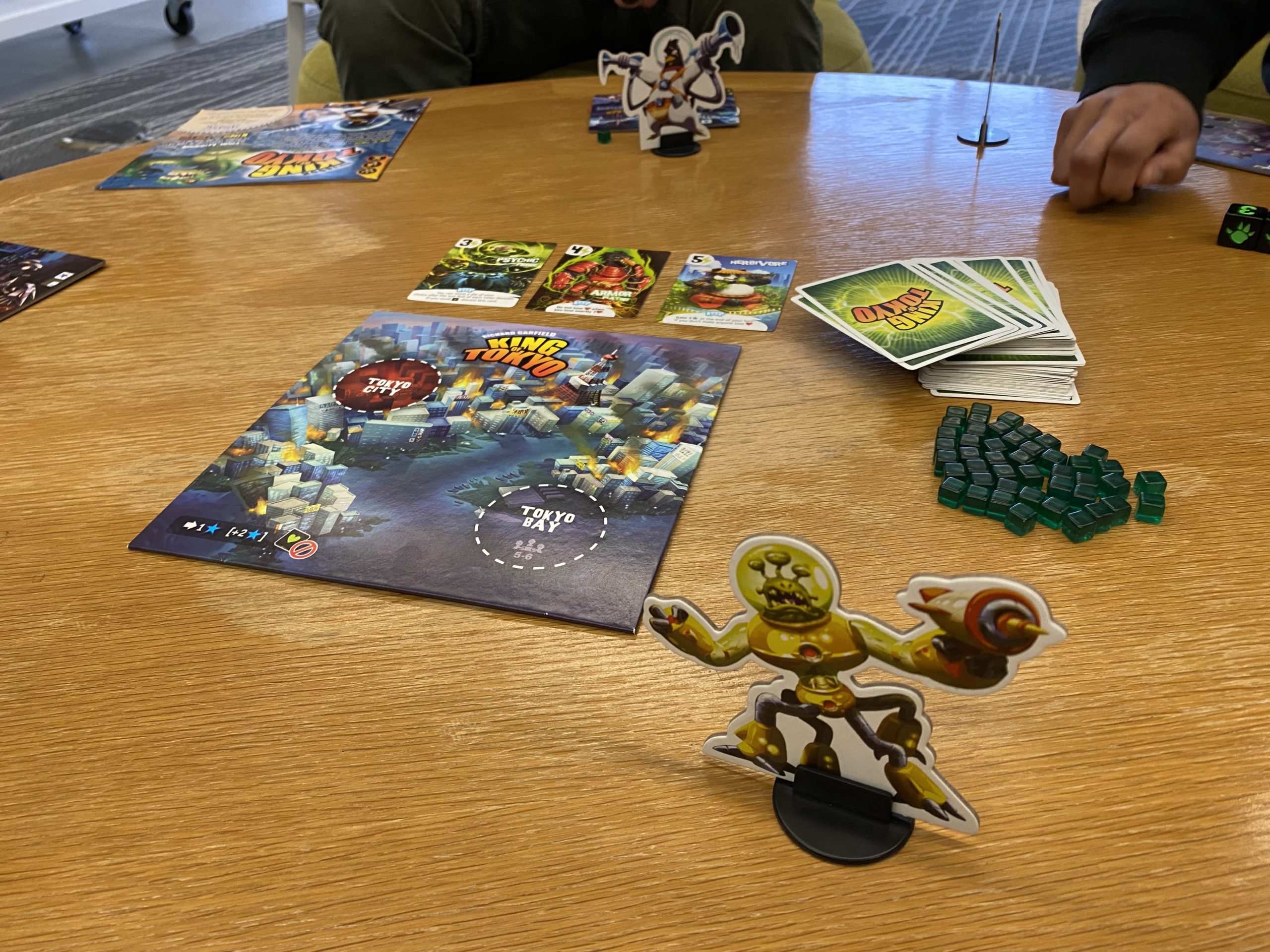King of Tokyo is a 2-6 player game where players aim on either being the last man (or in this case monster) alive or the first one to reach success by earning 20 victory points. Designed by Richard Garfield and released in 2011, King of Tokyo was a pleasant surprise involving a nice mix of strategy, chance, risk and reward and it is all thanks to such a simple mechanic everyone knows and loves: dice rolling.
The board game consists of many visually amusing and satisfying pieces including cardboard “character sheets” that help keep track of your health and victory points throughout the game. For each monster there is a small cardboard cutout of them that represents your position in the game where when you’re able to, you can place them on the small board that shows Tokyo in flames, reminiscent of the kaiju genre. There are also small green energy cubes and a deck of cards filled with power ups we can purchase using the energy we gather.
All of these pieces definitely contribute to the game’s fun and quirky aesthetics, but most of what makes this game so engaging is the power the dice hold. Initially starting with 5, these 6-sided dice are at the core of the game. These custom dice only include numbers 1-3 on half of their sides, with a symbol of a heart, a claw, and a lightning bolt on the other ones and depending on which ones they land determines how many points you earn, health you gain, damage you do to other players or energy you collect.
Like Yahtzee, you can roll the dice up to three times and are able to decide which ones to keep or reroll during at any time during these rerolls.
Prior to beginning King of Tokyo, the other players and I just finished playing Catan, and it’s perhaps because of Catans emphasis on winning through “Victory Points” that our initial thought was that it would be easier to win King of Tokyo through victory points than by total annihilation. In addition, in order to decide who goes first, the game asks for everyone to roll and whoever has the most claws wins yet somehow our entire group went in a circle with zero claws until the last person got one. This gave us a false sense that for some reason “Attacks” were hard to come by, once again making us believe it would be more important to invest in gaining more victory points than attacking the opponents in Tokyo. However, as our first playthrough would show us, the game can immediately shift in one turn.
For starters, because once someone enters Tokyo everyone is able to attack them, the player “in Tokyo” must play this game of risk as they calculate whether it’s worth surviving another round in the city or if it’s better to retreat before being completely wiped out. The dice rolling mechanic adds this level of luck since it’s not guaranteed what one will roll, but the strategy comes in deciding which dice to reroll or keep.
Do you keep the 3 in hopes to roll 2 more and gain 3 victory points? Or perhaps you are able to roll four more claws and wipe out a player? But what about that heal you so desperately need? All of these questions are what keeps the game interesting, and in addition the inclusion of the “Bonus Cards” where you can buy power-ups from the cubes adds an extra layer of randomness as well as a chance for people to make game-changing moves. For example, perhaps you can’t afford to buy a card that could help you win, so you decide to use two of your energy cubes to reshuffle the shop to prevent a player from gaining an advantage you cannot afford.
Actions like these would make us mad at each other sometimes, but in a playful manner which would keep everyone at the edge of their seats. Probably the most interesting example of these cards bringing unexpected results was when one of our players accidentally put herself in a “soft-lock” where she could not leave Tokyo because one of her Bonus Cards prevented her from receiving damage if the attack value was one. The funny part was in the fact that she was at 2 HP, so even though she wanted to leave when she only received one damage to heal, she was unable to do so because of her power-up, and if someone rolled 2 attack dice, she would be out of the game.
Initially, we all found this situation humorous and were all sure she would probably be wiped out by the next round. In an unexpected turn of events however, she was able to roll a perfect five attack dice, wiping out all the monsters outside of Tokyo and leading to her victory!
Some may say this makes the game unfair or imbalanced, but I argue that it is huge, unexpected moves like such that allow King of Tokyo to be this fun, fast-paced game that keeps players on their toes and allows for countless possibilities to occur in multiple play-throughs. Since then, I’ve introduced this game to many of my friends, and I’ve found it most satisfying when it’s played with a large group of people since it increases both the randomness pool as well as risk in staying in Tokyo (since it would take longer for it to be your turn). And by the time a game is over, the first question my friends ask is “Who’s down for another round?”.
